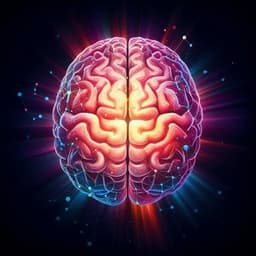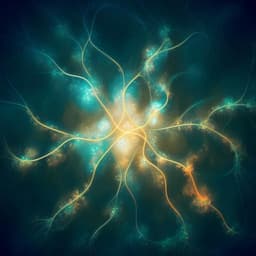
Engineering and Technology
Dynamics of lattice disorder in perovskite materials, polarization nanoclusters and ferroelectric domain wall structures
J. Očenášek, J. Minár, et al.
This research unveils an intriguing connection between classic ferroelectricity and lattice disorder in perovskite materials, conducted by Jan Očenášek, Ján Minár, and Jorge Alcalá. Through advanced simulations, the authors reveal the fascinating roles of cation hopping and polarization nanoclusters in shaping domain wall structures, all while exploring the potential control of lattice disorder via shear strain.
~3 min • Beginner • English
Introduction
The study addresses how lattice disorder underpins classic ferroelectricity in ATiO3 perovskites, focusing on the finite-temperature dynamics of central cation (Ti) displacements and their consequences for polarization, phonons, and domain wall structures. Traditional displacive models treat Ti atoms at or near equilibrium positions along high-symmetry directions, while experimental and theoretical work supports an eight-site order–disorder picture with Ti off-centering along specific <111> directions. Reconciling apparently conflicting Raman (mean positions) and XAFS (instantaneous positions) observations suggests a dynamical hopping/tunneling paradigm for Ti cations. The paper aims to clarify the role of dynamic lattice disorder in producing minimum-energy <100> pathways, polarization nanoclusters, soft phonon modes across phase transitions, and the structure and stability of ferroelectric domain walls, as well as to explore mechanical routes (shear, pressure) to manipulate phases and morphotropic phase boundary-like nanostructures. The significance lies in linking atomistic dynamical disorder to macroscopic ferroelectric responses and providing guidance for tuning properties via defects, light, and mechanical stimuli.
Literature Review
Prior work established order–disorder behavior in perovskites (eight-site model) with Ti off-centering along <111> directions producing net polarizations characteristic of rhombohedral, orthorhombic, and tetragonal phases. Experimental techniques (Raman vs XAFS) probe different time scales, leading to support for both displacive and order–disorder pictures, reconciled by dynamic hopping of Ti between off-center sites. Soft phonon modes during phase transitions have been linked in quasi-static DFT to bond softening along certain directions, but their connection to dynamical hopping remained uncertain. Effective Hamiltonian and MD approaches have explored hopping processes and mixed order–disorder character near cubic transition. Recent DFT shows certain disordered motifs can be lower in energy than hypothetical ordered cubic phases, and experiments report nanoclusters and local symmetry breaking in paraelectric and higher-temperature phases, as well as the role of charged defects and surfaces in stabilizing local polarization. Domain wall physics includes mixed Bloch–Néel–Ising characters and charged DWs with electronic effects; light-induced DW motion has been observed but mechanisms at larger length scales remain under discussion. MPBs and associated hierarchical domain structures are known to enhance piezoelectricity, often interpreted via polarization rotation and monoclinic bridging phases.
Methodology
Molecular dynamics (MD): Large-scale adiabatic MD with an isotropic anharmonic core–shell model fitted to ab initio (PBE GGA) data. Each atom comprises a massive positively charged core and a nearly massless negatively charged shell; short-range shell–shell Born–Mayer–Huggins interactions (cutoff 9 Å) and electrostatics via Wolf method (cutoff 11 Å, damping 0.25 Å−1). Potentials: BTO parameters from Vielma et al. (with checks using Sepliarsky et al.); PTO from Wu and Cohen. Simulations used LAMMPS, time step 0.4 fs. Supercells: triclinic 60×60×60 BTO unit cells (~1 million atoms) with periodic BCs for lattice disorder, nanoclusters, and phonon analyses. Initial poling under 20 MV m−1 followed by 20 ps NPT relaxation at target temperature to set the stable isomorph; for phonon dispersions, microcanonical NVE runs with 6 realizations (20 ps each) for statistical robustness and to avoid thermostat/barostat artifacts. Defect model: 0.01 at% charge defects by randomly charging 0.025% Ba atoms +1 qe and 0.025% Ba atoms −1 qe. Domain walls (DWs): 300 K, NPT, supercell 100×100×20 BTO unit cells for stable 180° and 90° head-to-tail DWs; polarization imposed with 20 MV m−1 for 1 ps, removed over 4 ps, then relaxed 40 ps. Unstable head-to-head DWs used larger 150×100×20 supercells under sustained 20 MV m−1 fields on both sides. Mechanical loading: For monoclinic subdomain emergence, equibiaxial in-plane strains εx = εy = 0.2% with out-of-plane relaxation; pressures reaching ~300 MPa led to transformations. Shear strain γ applied to study polarization rotation response (monoclinic distortion). Computational resources: ~100 h per large MD run on 128 CPU cores (2.4 GHz), ~6× more for phonon analyses. Density functional theory (DFT): VASP (PAW, PBE), energy cutoff 530 eV, electronic convergence 1e−8 eV, ionic forces 1e−7 eVÅ−1. Phonons by frozen phonon on 2×2×2 supercells, postprocessed with Phonopy. Note: DFT harmonic phonons at 0 K can show imaginary (negative) frequencies where effective stiffness is negative; MD phonon spectra reflect finite-temperature anharmonic dynamics with real frequencies. Calculations of local polarization P: from instantaneous positions and charges of Ti and its 14 nearest neighbors (8 Ba, 6 O), weighted by stoichiometry, normalized by local unit cell volume. Configurational energy: weighted average of core and shell potential energies of Ti and its 14 neighbors to capture nonlocal lattice configuration effects. Phonon spectra from MD: compute k-space velocity autocorrelations of core particles and power spectral densities along selected Brillouin zone paths; partial spectra resolved by Cartesian components and by species (e.g., Ti-only).
Key Findings
- Dynamic lattice disorder pervades BTO orthorhombic, tetragonal, and cubic phases, breaking them into ensembles of distorted rhombohedral motifs. Distributions of distorted lattices correlate with minima in configurational energy mapped in polarization space P, revealing one, two, and three minimum-energy <100> pathways in orthorhombic, tetragonal, and cubic phases, respectively.
- Polarization nanoclusters form and propagate ultrafast along active O–Ti–O <100> chains in all disordered phases. Nanoclusters are smaller at higher temperatures due to more active intersecting pathways; polarization nanovortices appear frequently at elevated T. Propagation resembles soliton-like traveling polarization packets along <100> directions.
- Time-averaging conceals intrinsic ultrafast nanoclusters over long bins (e.g., 150 ps), yielding vanishing local polarization in cubic paraelectric BTO; however, randomly distributed charge defects (0.01 at%) stabilize extrinsic, coarser nanoclusters observable even with long averaging (e.g., 250 ps).
- Finite-temperature phonon dispersions from MD show highly delocalized (scattered/broadened) soft transverse optical (TO) modes across BTO phase transitions along Brillouin zone directions aligned with active <100> pathways (Γ–X–S). Soft mode scattering spreads over ~100 cm−1. Associated longitudinal optical (LO) mode near Γ also softens. The soft modes originate from Ti oscillations along <100> pathways, consistent with Ti fluctuation periods of 0.2–0.5 ps (frequencies ~165–65 cm−1) observed in MD.
- In contrast, ordered tetragonal PTO at 300 K shows more localized soft TO modes (narrower), indicating constrained Ti vibrations near equilibrium points.
- Domain walls at 300 K in tetragonal BTO: stable 180° head-to-tail DW exhibits abrupt reversal of fourfold Ti-shift distributions (Ising-like) with essentially vanishing thickness; stable 90° head-to-tail DW shows gradual rotation via selective activation/deactivation of <100> pathways (Néel-type), thickness ≈1.5 nm, with net [110] polarization at the DW center via hopping across equal-probability <100> pathway. Charged head-to-head DWs (90° and 180°) are thicker (~4 nm), unstable, and exhibit locally orthorhombic lattices with a single active <100> pathway at the center and zig-zag morphologies.
- Mechanical stimuli: Small shear strains γ rotate polarization via induced monoclinic distortions in both BTO and PTO, but disordered BTO shows larger rotation angles δ for the same γ (easier polarization rotation) than ordered PTO with hindered Ti shifts.
- Under equibiaxial in-plane compression with out-of-plane relaxation, a preexisting 90° head-to-tail DW structure in tetragonal BTO becomes unstable at ~300 MPa (σxx = σyy ≈ 450 MPa, σzz ≈ 0), spontaneously forming zig-zagged monoclinic subdomains (twinned) within parent tetragonal stripes. Subdomains show Ti oscillations along a single <100> pathway akin to orthorhombic phase and maintain overall polarization direction of their parent stripes; twin boundaries are coherent head-to-tail interfaces.
- Implications for morphotropic phase boundaries (MPBs): Hierarchical monoclinic nanostructures with local polarization rotations can be mechanically induced at moderate pressures aided by surface strain relaxation, offering routes to tailor MPBs in thin films and enhance piezoelectric responses.
- Proposed mechanism for light-induced DW motion: oscillatory electric fields from polarized light aligned with specific crystallographic directions can favor spreading of dual <100> pathways toward the 90° head-to-tail DW center, enabling controlled DW motion; analogous effects are not expected for 180° head-to-tail DWs.
- Quantitative parameters: supercells up to 60×60×60 BTO unit cells (~1 million atoms); applied electric field 20 MV m−1; time bins 15–250 ps for averaging; DW thicknesses ≈1.5 nm (stable 90°) and ~4 nm (unstable head-to-head); Ti fluctuation periods 0.2–0.5 ps; soft TO scattering ~100 cm−1; pressure threshold ~300 MPa.
Discussion
The results establish a direct link between dynamic lattice disorder and key ferroelectric phenomena. Mapping configurational energy in polarization space shows that Ti hopping along emergent <100> minimum-energy pathways drives both the formation/propagation of polarization nanoclusters and the emission of soft phonon modes across phase transitions. The delocalized soft TO modes observed in finite-temperature MD arise from transverse waves associated with Ti fluctuations, distinguishing disordered phases (broad, scattered modes) from ordered ones (localized modes in PTO). Long-range polarization coupling organizes disordered lattices into nanoclusters without a static matrix, with size limited by depolarization fields and pathway intersections; charge defects and surfaces can stabilize extrinsic clusters, explaining experimental observations. Domain wall structures at finite temperature reflect local rearrangements of disorder—selective activation/deactivation of <100> pathways—reconciling Néel/Ising behaviors and clarifying why charged head-to-head walls are thick and unstable. Mechanical loading alters pathway activation: shear facilitates polarization rotation in disordered BTO more than in ordered PTO, and biaxial pressure with relaxation triggers monoclinic subdomain formation (akin to MPB nanostructures) by enabling local out-of-plane shear accommodated at coherent twin boundaries. These insights unify dynamic disorder, phonon anomalies, nanoscale polarization textures, and DW mechanics, and suggest external fields (light) and mechanical stimuli as practical levers to control ferroelectric functionality.
Conclusion
This work demonstrates that finite-temperature lattice disorder in perovskite ferroelectrics breaks average phases into ensembles of low-energy rhombohedral motifs and generates minimum-energy <100> pathways that govern Ti hopping, polarization nanoclusters, and soft phonon modes. Large-scale MD and complementary DFT connect delocalized soft TO/LO modes to Ti fluctuations, reveal ultrafast nanocluster dynamics and defect-stabilized extrinsic clusters, and elucidate finite-temperature domain wall structures via pathway activation/deactivation. Mechanical shear readily rotates polarization in disordered BTO (vs ordered PTO), while moderate biaxial pressure with strain relaxation induces zig-zagged monoclinic subdomains and hierarchical MPB-like nanostructures, suggesting routes to tailor properties in thin films. A light-driven DW motion mechanism is proposed via selective pathway spreading at 90° head-to-tail walls. Future research directions include experimental probing of shear-induced polarization rotation to diagnose lattice disorder, in situ studies of defect-stabilized nanoclusters and light-driven DW mobility, and exploiting mechanically assisted MPB formation in nanoscale devices, guided by high-fidelity, finite-temperature atomistic simulations.
Limitations
- Observation challenge: Ultrafast intrinsic nanoclusters are concealed by time averaging over long windows; experimental detection is difficult without defects or surface termination effects to stabilize extrinsic clusters.
- Nanocluster sizing: Objective assessment of nanocluster size distributions is hindered by their dynamic breakdown and dependence on local fluctuations.
- Modeling artifacts/assumptions: DFT harmonic phonon calculations yield imaginary frequencies (negative branch segments) that are computational artifacts not present in finite-temperature MD. MD potentials are parameterized from 0 K ab initio data; while robust, they approximate true interatomic interactions. The point-defect model uses idealized ±1 qe charges on Ba sites at low concentrations.
- Scope: Findings are based on simulations (albeit large-scale) and specific materials (BTO, PTO) and potential parameter sets; quantitative thresholds (e.g., ~300 MPa) may vary with experimental conditions and microstructure.
- Finite-size/time: Despite million-atom cells and multiple 20 ps realizations, finite simulation times and periodic boundary conditions may limit access to slower kinetics or larger-scale heterogeneities.
Related Publications
Explore these studies to deepen your understanding of the subject.







